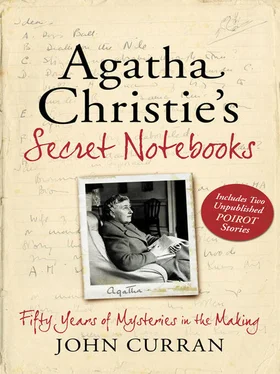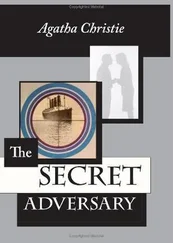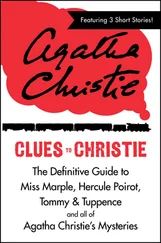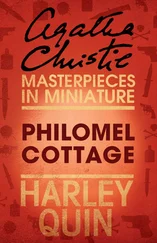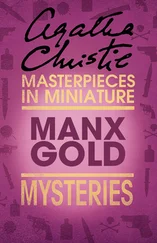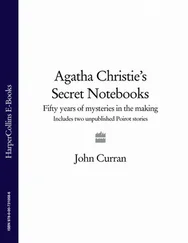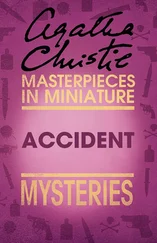Although thallium—the murder method in The Pale Horse—was used many years earlier by her great contemporary Ngaio Marsh in her novel Final Curtain, it was Christie’s novel that gained notoriety in the UK in June 1972 when Graham Young was convicted of the murder of two workmates and the attempted murder of two more using the same poison. Both the novel and Agatha Christie were mentioned during the trial. Although Young denied having read The Pale Horse, an enterprising reporter contacted Christie to get her reaction. She explained that she had used it in the novel as it was unusual and interesting for a detective novelist, being tasteless and odourless as well as difficult to detect.
Although the notes are scattered over five Notebooks, the basic plot was established early on, as were some of the characters. Notebook 38 contains a sketch of the opening pages although the woman is not found dead, but dies shortly after Father Gorman’s ministrations. It seems that from the beginning thallium was to be the murder method. And the coffee bar scene, with the important hair-pulling incident, appears in the novel exactly as it does here:
The Thallium Mystery
Start somehow with a list of names e.g.
Sarah Montfort
Anthony West
Mrs. Evershed
Lilian Beckett—
Jaspar Handingly—All of them dead
A woman—hospital nurse—found dead—the place ransacked—she says list—all dead
They are all dead
Begins—coffee bar—the girls fight—one pulls out fistful of other one’s hair
Police? Girl is good sport—says didn’t really hurt
The formula—paid agents—women who go round—report on medicine bottles etc.—they do several houses in neighbourhood—report on the N.H. service
She then worked on the mechanics of the business of the ‘death broker’—a good description—as well as some of his potential ‘customers’. She did not pursue the thought of using Poirot but settled for her second possibility—‘plain’, in other words not part of a series:
Book
Thallium? Series of poisonings going back over years? Hair falling out only symptom in common
Poirot?
Plain?
A ‘Death Broker’—you pay—the person concerned goes—by various natural causes
Idea like killing off jury (or Ten Little Niggers? )
No apparent connection—But there is one. What?
The idea of the Murder Syndicate arranged by (?) Osborne—a strange dual personality—a respectable family—not a bad lot—leaves home, wild, comes back the Prodigal Son—but middle class respectability not enough for him—when Father dies—well off- opens branches in 3 districts run by his assistants—he is at other ones always—actually has a second life abroad?
It is not entirely clear if Dr Corrigan, mentioned in the following extract as a possible partner in crime, was to have been a relation of Ginger’s, but Osborne was the villain of the piece from the start. And the outline below is accurately reflected in the published novel, although not all of the elements—Dr C is not ‘in it’ (he is a police surgeon) and Venables’ name is not on the original list—were incorporated and three ‘witches’ names were to change:
Ideas
(1) Ginger is Ginger Corrigan—Heiress to money?
(a) Her would-be killer is in Fete party—man’s wife
(b) Doc. C.[orrigan] is in it—he and Osborne? Object—to set up big research unit abroad
(2) Osborne—a double life character—father was respectable prosperous old fashioned pharmacist—other O. ran off as boy—went on stage—impersonator
Rough idea of how the racket is worked—The organisation? Double life—a chemist (shop)
A rich man—crippled—collects silver—his name will be ‘on list’ (false)—his niece or nephew will be framed.
Others—1st Business man—office—or meet in park
2nd weird sisters—ritual
3rd employed person to make enquiries as to medicines etc. by victims—Consumer research it—replacing of some medicament by thallium
Head man Dr. C? Osbourn
False head adam’s apple—Mr Vuillaumy [Venables] Rich eccentric
Next:
Samuel disbarred lawyer
3 W[eird] Sis[ters]
Thelma French—Sybil White (or Greek name)—Alison Wilde—cook—village witch
Does Osborne come to Fete from Bournemouth—accosts—comes to Mark—rang up Dr. Corrigan
or police? Saw the man—describes him—scene in chemist’s shop at Bournemouth
One intriguing possibility for this novel was the introduction of Miss Marple. This is not as unlikely as may at first seem. The novel features quite a number of elderly women in a small village, as well as her old friend from The Moving Finger, Mrs Dane Calthrop, so Miss Marple would have felt quite at home. Christie toyed with two ideas for involving her, both very feasible—as a neighbour of one of the victims or as a great-aunt to Mark Easterbrook:
The Pale Horse Extra notes
Near Miss Marple one of the ‘Names’ lives
Is ‘Mark’ Miss M’s great nephew (Raymond’s son)
Three ‘weird’ sisters—living at the ‘Pale Horse’ formerly an inn—inside is picture framed—formerly the Inn Sign at end Mark (?) cleans it—the rider skeleton appears—Miss M gives quotation from Revelations
Thelma Grey is owner of Pale Horse—her family came from Ireland—witchcraft—her gr-gr-gr-etc. aunt burnt as a witch (probably all lies somebody says!). She talks about witchcraft—and what it is
Finally, Notebook 6 has an unexpected jotting:
Pale Horse Play?
Expresso 2 girls—Andrew startled
That’s all—nothing more exists. It is difficult to see how the novel could have transferred successfully to the stage. Perhaps the discussion on Macbeth and its Three Witches encouraged Christie to consider an adaptation but, practical difficulties aside, it was not a suitable case for dramatisation.
The Mirror Crack’d from Side to Side
12 November 1962
Out flew the web and floated wide; The mirror crack’d from side to side ‘The curse has come upon me,’ cried The Lady of Shalott.
Tennyson, The Lady of Shalott
What was it that film actress Marina Gregg saw in her home, Gossington Hall in St Mary Mead, that caused her to ‘freeze’, just before a murder was committed there? Further attempts on Marina’s life and three more deaths follow before Miss Marple can explain the look of doom.
The Mirror Crack’d from Side to Side is the last of the village murder mysteries. Christie began work on this in late 1961 and by January of the following year was well advanced. But when the manuscript was submitted, in April 1962, there was a spate of concerned correspondence between her agent and publishers and at one stage it was doubtful if the book would be ready in time for the Christmas market. The early mention of German measles in the first draft was considered such a giveaway, although its complete omission was felt to be unfair, that a rewrite was called for. The first person to read it when the manuscript was received at Collins successfully predicted not only the killer but the motive also, long before the first murder was committed. And after its publication the problem rumbled on with the receipt of a letter from an angry American reader bitterly complaining about the motive and its lack of sensitivity to a tragedy in the life of the well-known actress Gene Tierney. Despite a reply from Edmund Cork to the effect that Agatha Christie knew nothing about this until long afterwards, the accusation is still resurrected from time to time.
The first six pages of Notebook 39 contain an embarrassment of riches in the shape of plot ideas. The first page is confidently headed ‘Miss M Book’ and in the course of the following pages the plot devices of The Clocks, A Caribbean Mystery and The Mirror Crack’d from Side to Side are all sketched, along with echoes of ‘The Case of the Caretaker’ (where Dr Haydock encourages her to unravel a ‘nice’ murder) as well as a short idea—the girl and the nasty fall—that appears as a throwaway scene in Chapter 2 of The Mirror Crack’d from Side to Side:
Читать дальше
Конец ознакомительного отрывка
Купить книгу
